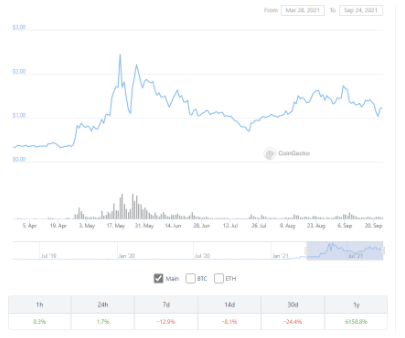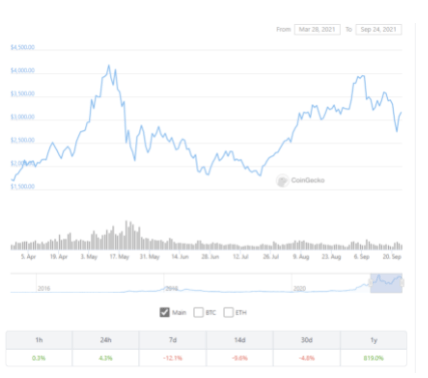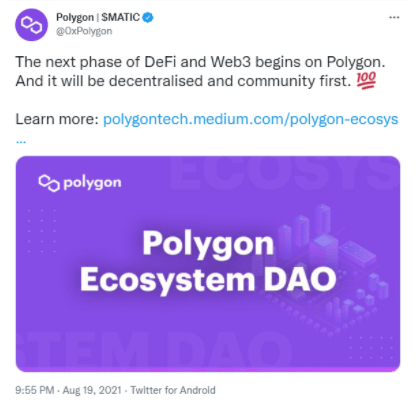What is MATIC and Why Should You Invest in It?
The world wakes up to a new cryptocurrency every month. The pace of innovation in the blockchain space is moving up a notch, and the cryptocurrency market will saturate fairly quickly.
In all likelihood, most of these will wither; their autumn isn’t too far. Once the fundamentally strong digital assets begin to reign over the crypto-verse, the market value of other coins that offer little value will leave their investors anxious.
A new name in the crypto-verse, MATIC, is turning heads and all investors should take note. Wonder why? MATIC has quickly grown to become the world’s 22nd largest cryptocurrency by market cap — in less than 4 years! Mark Cuban, a billionaire and a crypto investor, also backs this relatively fresh crypto coin.
Of course, this isn’t all that’s gold about MATIC. It also has a strong value proposition that puts some of the most pressing concerns of one of the world’s largest blockchain networks, Ethereum. If this sounds vague, let’s draw a picture and see what MATIC is, and why investors may want to consider getting a piece of the pie.
What is MATIC and why should you invest in it?
MATIC (now being rebranded as Polygon) is an Indian blockchain scalability solution; they’re calling it the Ethereum’s Internet of Blockchains.
The Polygon Network aims to find solutions to Ethereum’s challenges of scalability by creating a multi-chain Ethereum-compatible blockchain ecosystem, also called sidechains.
Think of sidechains are blockchains that are connected to the larger Ethereum blockchain to support a broad range of DeFi protocols on Ethereum. Polygon’s comparable companies include Avalanche, Cosmos, and Polkadot.
MATIC is the native cryptocurrency of the Polygon network. It’s used for settlements among participants on the Polygon network. Essentially, MATIC to Polygon is what Ether is to Ethereum.
Reasons to invest in MATIC
MATIC is prone to the same risks as any other cryptocurrency. While it offers ample value and dozens of use cases, investors should not invest money they cannot afford to lose.
Before getting carried away, spend a moment thinking about what happens if that emergency fund gets washed away — which isn’t entirely unheard of in the crypto-verse. With that out of the way, consider the following reasons that may warrant investing in MATIC, preferably with a long-term view.
1. Impressive performance
People invest to earn money, period. Regardless of how popular or good a coin is, it doesn’t do much for the investor unless it generates some tangible returns. Fortunately, MATIC investors did a little happy dance last quarter when most cryptocurrencies took a dive as deep as the Colca valley.
MATIC pulled off outperforming the likes of Ethereum, too. To get some context on how investors would have gained by investing in MATIC vs Ethereum, the following price charts may be helpful.
Ethereum:
Over the previous year, Ethereum generated roughly 800% return. Undeniably impressive performance considering that there was a sharp drop in prices between the May to July period this year.
MATIC on the other hand, returned roughly 6000%! That’s over 7x returns that Ethereum generated. Considering that MATIC is a digital asset, the success of which is largely tied to that of Ethereum’s, the 6000% should pop a few eyes out.
This shows the asset’s resilience to tough times. Even if investors believe this isn’t true, they can’t deny the fact that there’s enough demand for MATIC to sustain the overall uptrend for the foreseeable future. Investors that are waiting for a dip should buy MATIC with a credit card right away; the dip isn’t coming anytime soon.
2. Fundamental strength
The importance of strong fundamentals can’t be stressed enough. Unless an asset creates tangible value by solving a problem, its long-term intrinsic value is likely less than its current price in most cases.
MATIC solves an actual problem by being a go-to platform for building blockchain applications and addressing the Ethereum blockchain’s limitations. Ethereum has three bottlenecks: low throughput, poorly governed community, and expensive gas fees.
This is where Polygon provides substantial value. It allows developers to create an Ethereum-compatible blockchain and access the main Ethereum blockchain ecosystem. Polygon is a protocol and framework that enables a developer to create and also connect Ethereum-compatible blockchain.
With one-click deployment and custom development modules, Polygon puts a lot of power in a developer’s hands. Polygon’s interoperability protocol makes communication between the main Ethereum blockchain and other networks easy. Plus, developers can also use adaptor modules that offer interoperability among existing blockchain networks.
Why does this matter? Well, DeFi is about to revolutionize global finance. The bottlenecks and ease of use will likely draw attention from developers that are central to this revolution — consider them the revolution’s warriors if you will. In a task that’s already fairly complex, a tinge of simplicity can provide a lot of utility.
The two-fold fundamental strength that comes from addressing Ethereum’s bottlenecks and offering simplicity to developers is at the core of MATIC. In the future, this is what’s likely to drive the price upward, making MATIC an asset worth considering for every crypto investor.
3. Polygon’s growth spree
Polygon caused quite a stir on August 19 after it announced on its Twitter handle that the upcoming phase of DeFi and Web3 has begun on Polygon, and it will be “decentralized and community first.”
Polygon witnessed a surge in activity on its native projects such as QuickSwap and Aavegotchi, and also a few Ethereum projects including Curve, Balancer, and SushiSwap — all of which leveraged Polygon to achieve their target of a million DeFi users. The projects also brought with them their community with an intention to capitalize on Polygon’s low gas composability.
In view of these events, Polygon announced the intention to build a DAO (decentralized autonomous organization) as part of their growth efforts. Polygon has set a target of 100 million users, to begin with. The DAO will facilitate collaboration among blockchain systems and revealed that it will need to withdraw about $100 million from its #DeFiforAll fund along the way.
The latest in Polygon’s growth story was Polygon’s acquisition of Hermez Network on August 13 in a deal valued at $250 million. The deal brought Hermez under Polygon’s control and added one more name under Polygon’s current portfolio featuring Polygon Avail and Polygon SDK.
All these events are a testament to Polygon’s growth spree. It’s growing and it’s not going to stop anytime soon. This presents a unique opportunity for investors that missed Bitcoin or Ethereum’s growth phase. If Polygon does replicate either of those blockchain’s performances, it could make investors unimaginably wealthy.
The Risk: The relationship between Polygon and Ethereum
It’s not surprising for investors to have not heard of MATIC so far, but not having heard of Ethereum would be absurd. The reason? Ethereum is the world’s second-largest blockchain network. A cryptocurrency investor who doesn’t know Ethereum is the same as an equity investor who doesn’t know Apple.
The reason Ethereum is an important part of the equation is that MATIC’s success is tied to Ethereum’s bottlenecks.
Granted, Polygon has a range of scaling solutions under its belt, but all of them are based on Ethereum. If a new programmable blockchain like Cardano manages to claim Ethereum’s spot in the future, Polygon’s solutions are at the risk of being rendered irrelevant. Polygon also faces stiff competition from the likes of Cosmos and Polkadot.
Plus, Ethereum 2.0’s rollout will likely complete sometime in 2022. When it does, there are chances that the upgraded Ethereum network will no longer have the bottlenecks that Polygon’s solutions address.
That said, risks play out in uncertain ways — otherwise, they wouldn’t be called risks. It’s unlikely that Ethereum will disappear from the market entirely even if another programmable blockchain does manage to claim a larger share.
The developers also argue that the upgrade won’t affect Polygon’s relevancy significantly because Polygon’s solutions can speed up transactions even more and facilitate communication between Ethereum and other networks.
Sound like a winner?
MATIC has all the characteristics of an attractive, investment-worthy asset. It has a terrific risk-return profile that makes it a possible investment choice for a much broader group of investors across the risk spectrum.
From fundamental strength to a capable team, Polygon has a lot going for it. The growth is visible in the price and now could be a great time for an investor to take a position.
The important thing though is to understand that literally none of the crypto coins are risk-free. The risk for MATIC is Ethereum 2.0, but of course, there’s a lot of uncertainty around how Ethereum 2.0 will actually perform and how much the current blockchain’s bottlenecks it will successfully remove.
For investors that believe they have the risk capacity to weather through any short-term swings, have capital that they can invest in a high-risk asset, and are confident about their decision are likely to benefit from Polygon’s growth over the next few years. Hopefully, Polygon will put stacks of cash in its investors’ bank accounts.
Author Bio: Arjun Ruparelia
Email – ruparelia.arjun@gmail.com
An accountant turned writer, Arjun writes financial blog posts and research reports for clients across the globe. Arjun has five years of financial writing experience across verticals. He is a CMA and CA (Intermediate) by qualification.




